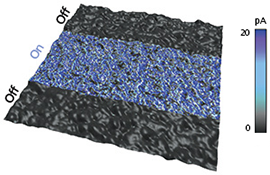10 Oct
New MFP-3D Infinity AFM Photovoltaic Option Offers a Turnkey Solution for Characterizing Photoconductive Materials

Over the past decade, atomic force microscopes (AFMs) have been instrumental in understanding the nanoscale morphology of photovoltaic (PV) materials, an essential step to improving their performance. However, characterising the photoresponse of these materials with the AFM has often required a great deal of custom instrumentation development on the researcher’s part. To simplify these measurements, Oxford Instruments Asylum Research announces the new Photovoltaic Option for the MFP-3D Infinity™ AFM. The PV Option provides researchers a turnkey solution with unmatched versatility for a wide range of sample heights and illumination sources. Together, the MFP-3D Infinity and PV Option enable high-resolution imaging and advanced electrical characterization with techniques such as conductive AFM (CAFM), electrostatic force microscopy (EFM), and Kelvin probe force microscopy (KPFM). These modes are critical for investigating photocurrent and related photoresponse, including effects caused by heterogeneous interfaces, grain boundaries and/or phase-separated domains. Additional information can be found here.
Asylum Research Applications Manager Jason Li explains, “In the past, it was common for researchers to spend considerable time customising hardware for photoconductive experiments. Like many Asylum products, we’ve learned a lot from their pioneering efforts and have designed a solution for easier measurements. The PV Option is ready to go right out of the box, making operation more streamlined, and can accommodate a wide range of experimental options. The PV Option also benefits from the MFP-3D Infinity AFM’s ultra-low-noise, robust platform, making it ideal for any lab setting.”
The PV Option expands the versatility of the MFP-3D Infinity AFM and is fully compatible with its entire suite of nanoelectrical and nanomechanical characterization techniques, creating limitless possibilities for experimental design. It is also compatible with an array of MFP-3D Infinity options including the Closed Fluid Cell, BioHeater™, and Humidity Sensing Cell that enable complete environmental isolation and control.
Image caption: The image shows current on 3D topography for CdSe on indium tin oxide (ITO) acquired with conductive AFM at +1 V bias. The PV Option was used to irradiate the sample at an intensity of 0.9 W/cm2 while scanning the middle of the scan area, inducing the measured photocurrent. Scan size 2 µm.



